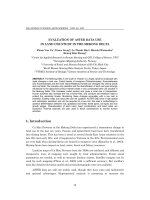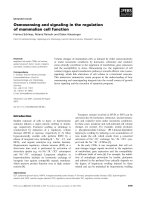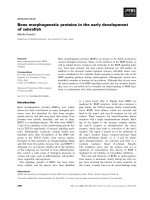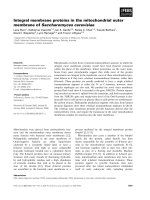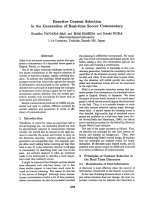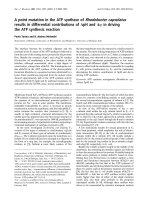Báo cáo "Evolution of holocene depositional environments in the coastal area from the Tien river to the Hau river mouths " pot
Bạn đang xem bản rút gọn của tài liệu. Xem và tải ngay bản đầy đủ của tài liệu tại đây (666.85 KB, 17 trang )
VNU Journal of Science, Earth Sciences 26 (2010) 185-201
185
Evolution of holocene depositional environments in the
coastal area from the Tien river to the Hau river mouths
Tran Nghi
1,
*, Nguyen Dich Dy
2
, Doan Dinh Lam
2
,
Dinh Xuan Thanh
1
, Nguyen Dinh Thai
1
, Tran Thi Thanh Nhan
1
,
Giap Thi Kim Chi
1
, Nguyen Thi Huyen Trang
1
1
Hanoi University of Science, VNU, 334 Nguyen Trai, Hanoi, Vietnam
2
Vietnamese Academy of Science and Technology,18 Hoang Quoc Viet, Hanoi, Vietnam
Received 3 December 2010; received in revised form 17 December 2010
Abstract. The Holocene coastal zone of Mekong river plain is the result of prolonged marine-
fluvial interaction. Lithofacies association in time and space is characterized by three depositional
system tract belonged to the upper part of a sequence stratigraphy. Based on lithology should be
divided 5 sedimentary types and 18 lithofacies distributed in stratigraphical column and in sea
bottom varying from 25m water depth to mainland coastal area. According to sequence
stratigraphy the transgressive systems tract at 5 Ky Bp, while from geochronology point of view
the boundary between Middle Holocene and Late Holocene is 3 Ky Bp – a regressive stage.
During Early-Middle Holocene stage transgressive depositional system tract is characterized by
two associated lithofacies upward section: delta front swamp mud rich in organic materials facies
and marine shallow grey-greenish clay facies corresponded with marine flooding plain. And then
Late Holocene regressive phase corresponding with Highstand systems tract composed of delta
plain clayish silt facies in which there are different sandy ridges generations distributed younger
seaward. Each sand ridge generation was mark by a coastal zone and associated lithofacies.
In circumstance of global climate change and sea-level rising, the Mekong river coastal zone will
be changed much more in framework of modern tectonic subsidence. If the rate of sea-level rising
is 2mm/year then sea bed will be subsided with a rate of 4mm/year. But recent rate of sediment
accumulation is over 4mm/year, so the modern coastline continue to prograde seaward with a rate
of 40m/year. The Mekong river mouths are migrating to East-North, and as a result geosystems
and landscapes are changing.
1. Introduction
∗
The study area is composed of Holocene
deltaic coastal zone belonging to Mekong plain
situated in South Vietnam (fig.1). Holocene
deposits in coastal area and shallow sea in front
_______
∗
Corresponding author. Tel.: 84-4-38542489.
E-mail:
of the Mekong river mouth were formed in
relationship with sea-level change during the
Flandrian transgression and the Late Holocene
regression. Sedimentary composition, thickness
and distribution of the Holocene deposits in the
study area are related with two important
factors: sea-level fluctuation and tectonic
movement. A regression during the glaciation
T. Nghi et al. / VNU Journal of Science, Earth Sciences 26 (2010) 185-201
186
Wurm-2 had created a condition for Late
Pleistocene alluvial deposits and weathering
crust (Q
1
3b
) to be formed. These deposits are
spread from the land to -100m water depth on
the shelf. The colorful clays contain a lot of
laterites nodules likes texture of bread with
graves. Waves and tides during the Flandrian
transgression had destroyed a surface deposits,
composed mainly of silty clay and laterite
nodules and transported them into new
depositional environments.
Fig.1. Position schema of study area.
T. Nghi et al. / VNU Journal of Science, Earth Sciences 26 (2010) 185-201
187
Distribution of the Late Holocene deposits
on the land as under the sea is following
mechanic differentiation and facies association
from the coast seaward by river flow and from
North-East to South West by long-shore drift
flows.
In coastal and shallow sea there are 5
sedimentary types and 18 depositional facies,
which were formed from Early Holocene to
present. On the map of the Late Holocene
lithofacies muddy clays alternated with sands.
Sands were formed mainly in river channels,
river sand bars and river mouth bars. Muddy
clays were formed in estuary, coastal swamps,
tidal flat, river mouth lagoon and deltaic plain.
Data used for this paper coming from
Project KC09.09/06-10. All results analyses of
grain size, mineral and chemical composition,
microfauna… from 5 deep boreholes of this
project were collected and interpreted for facies
analyze as well as for sequence stratigraphy to
express all composition and evolution of the
depositional environments in coastal and
nearshore area from 12Ky Bp to present.
Study on facies changing in time and space
helps to determine river mouth changes and
paleocoasts during the Holocene. Based on this
study we can predict a trend of river mouth
changing with climate change and sea-level
rising in the future for planning and coastal
sustainable development.
2. Study methods
2.1. Methodology
Study sedimentary evolution of fast
growing river delta such as the Mekong delta
should based on two approaches: system
approach and evolution approach. Sedimentary
types and lithofacies systematically related. A
big system is composed of smaller systems. For
example, deltaic group is composed of delta
plain, delta front and prodelta. Delta front is
composed of river mouth sand bars facies, river
mouth lagoon clay facies, sand of tidal flat
facies…
From geological time point of view,
evolution of deposits in river mouths of an
aggradational deltas will follow a grainsize,
lithofacies, mineral composition and
sedimentary geochemistry periodicity
Holocene deposits of the Mekong river
mouths belong to the upper part of a sequence,
that consists of two depositional systems:
transgressive system track (TST) and highstand
system track (HST). Transgressive system track
consists of 2 parasequences, corresponds to 2
depositional facies: organic transgressive
deltaic muddy clay and lagoon grey-greenish
clay facies. Highstand system track is
composed of a group of regressive deltaic
deposits.
2.2. Study methods.
- Grain size analysis and data processing
A results of grain size analysis will be
processed following a formula: Φ= -log
2
d in
which d is a diameter of grain (mm). An
accumulative curve of grain size allows
calculate grain size parameters: Md, So and Sk.
A grain size analysed results will be plotted on
the schema of sedimentary classification of the
Royal British Geological Survey (fig.2).
- Petro-mineralogical method analysis
This method includes study of thin section
under polarized microscope of non-cemented
sediments and analyze of minerals under
stereoscope microscope. An analyze result of
clastic minerals and molluscs will help in
classification of rocks according Petijhon
(1973) classification when apply for
sandstones. Analyze under stereoscope
microscope will be useful for determining a
composition (Q, F, R) and morphology of
clastic grains (Ro, Sf).
T. Nghi et al. / VNU Journal of Science, Earth Sciences 26 (2010) 185-201
188
Silt/clay ratio
s
a
n
d
/
m
u
d
r
a
t
i
o
(
n
o
t
i
n
s
c
a
l
e
)
9:1
1:1
1:9
1:2
2:1
Clay
Silt
Sand
1
1a 1b
2a 2 2b
77a 7b
6
(1) (2)
Fig.2. Schema of sedimentary classification (After Royal British Geological Survey, 1979).
(1)-Deposits contain gravels. Schema has 3 parts: gravels, sand and mud (silt + clay)
1. Mud
2. Sandy mud
3. Slightly gravelly mud
4. Slightly gravelly sandy mud
5. Gravelly mud
6. Sand
7. Muddy sand
8. Slightly gravelly muddy sand
9. Slightly gravelly sand
10. Gravelly sand
11. Slightly muddy sand
12. Muddy gravel
13. Muddy sandy gravel
14. Sandy gravel
15. Gravel
(2)-Deposits do not contain gravels. Schema has 3 parts: sand, silt and clay
1- Mud
a - Clay
b - Silt
2- Sandy mud
a - Sandy clay
b - Sandy silt
3- Muddy sand
a - Clayish sand
b - Silty sand
- Lithofacies and sequence stratigraphy analysis
Lithofacies analysis is determination of
different facies names and association of
lithofacies in space and time, based on
geochemical, environmental and depositional
parameters as well as on texture and structure of
sediments. In this paper following geochemical
environmental and depositional parameters are
used: pH, Eh, Kt, So, Ro, Q, Cl/S.
Depositional environments have been
determined using different structures of
deposits:
- River channel deposits have a cross
stratification
- Flood plain deposits have a ragged parallel
stratification
T. Nghi et al. / VNU Journal of Science, Earth Sciences 26 (2010) 185-201
189
- River mouth deltaic tidal flat deposits
have a cross stratification.
- Nearshore deposits have a wave
stratification
- Delta front deposits have a progradational
sigma structure
Lithofacies analysis results are backgrounds
for sequence stratigraphy analysis in
circumstance of Early-Middle Holocene
transgression, Late Holocene regression and
recent transgression.
3. Characteristics of lithofacies
3.1. Characteristics of the Early Holocene
lithofacies (Q
2
1
)
Tidal flat sand and supretidal mud appear in
deep boreholes BT3, BT2 and BT1 from 39m to
59 m (fig.9). Tidal flat sands are well to
intermediate sorted but supretidal mud is
weakly sorted because of different grainsize
composition. These tidal flat deposits are
transitional so they have almost the same
geochemical parameters (pH=7-7.8; Kt= 0,8-
1,6) (Tab.2).
Many coastal lithofacies associated each
other in space and time. In space can be
observed a transition from coastal swamp mud
to river mouth channel sand, sand ridges and
lagoon mud facies. In cross section, upward can
be observed a facies replacement from river
mouth sand bar by tidal flat muddy clays and by
coastal swamp muddy clay facies at the end.
A group of submarine Middle-Early
Holocene marine facies composed of two
facies: a shallow marine sands and gravelly
sands are spread from 25 m water depth
shallow sea. They are a product of denudational
and redepositional processes of the Flandrian
transgression. The boundary between these
sediments and the underneath Late Pleistocene
deposits is transgressive ravinement surface as a
result of wave and tide action. Therefore, a
certain quantity of laterites, coming from
motley coloured clays always is available in
these sands (fig.3,4,5). The Holocene deposits
distributed in coastal zone of Mekong delta
consist of 18 facies which are expressed on the
map of the Holocene deposital environments
(fig.7). However, in this paper ones important
of them were only described in detail the
lithological, environmental characteristics and
distributed regulation in space and time.
Fig.3. Well rounded laterite gravels (L) in shallow marine zone
(lithofacies 16 showing in fig.7) (Q
2
1
) – N
+
x60.
L
L
L
L
L
T. Nghi et al. / VNU Journal of Science, Earth Sciences 26 (2010) 185-201
190
Fig.4. Reb-brown color laterite grains (L) was
redeposited from Late Pleistocene Laterited clay
layer (Q
2
1
-N
+
x 60).
Fig.5. Paleo shallow marine, well rounded,
monomineral, fine sand richen in volcanic fragments of
rocks (Ro >0,6) (m/SQ
2
1-2
) – N
+
x30.
3.2. Late Holocene lithofacies
3.2.1. Sand ridge facies (amSQ
2
3a
)
Sand ridge has a sickle, kidney or bow-
shape, simple or branched of with a back
seaward. This sand ridge is composed mainly of
sand (60-80%), silty clay and mollusc, therefore
its colour is brownish yellow-typical colour of
oxidized environment [11,12]. The elevation of
these sand ridges is about 2-7m, their width
varies from 100 to 3000m. They distributed
parallel to the shore in the form of bows with a
distance from each other about 3-10km. They
are evidences of paleocoast existence during
delta progradation from delta front into delta
plain. Due to these sand ridges delta plain in
study area has a typical wave relief with the
ages younger seaward. Sands in these sand
ridges always are well sorted (So≤ 1,5), their
roundness is from average to good (Ro>0,5)
(Fig.6) [10].
Fig.6. Ancient river mouth sand ridge. Feldspar Quartz sand, average to well rounded,
well sorted (am/SQ
2
3a
) – N
+
x60.
L
L
L
T. Nghi et al. / VNU Journal of Science, Earth Sciences 26 (2010) 185-201
191
3.2.2. Delta plain sandy mud facies
(amf/MQ
2
3a
)
This lithofacies is well spread on the land of
the study area. This facies alternated with a
sand ridges and old swamp mud facies. It
composed mainly of silty clays (50-70%) and
fine sand (30-50%). Its colour is grayish brown
to blackish gray. They were formed mainly by
sedimentation of suspended materials during
flooding of delta plain area. Therefore this
deposits are bad sorted (So>3) and always
contains a lot of leaves and steams, sometime
brackish molluscs also available. The pH value
of clays varies from 6,9 to 7,5, Eh from -20mv
to +150mv and Kt from 0,7 to 1,4. These
environment indicators proved a brackish
transitional environment from river to the sea
(Tab.2)
3.2.3. Coastal swamp mud facies (amb/MQ
2
3a
)
This lithofacies is distributed in narrow area
between delta plain mud and river mouth sand
ridges, created a low-lying relief parallel to the
ancient coast. Their colour is black or blackish
grey. They are composed mainly of silty clays
(50-80%) and fine sands with an organic
matters. Somewhere a peat is available at the
depth of 0,5 to 2,0m [11,12]. The value of pH
and Eh in deposits vary according to their
colour and grain size composition. Where black
mud is dominated a value of Eh always less
than 0 and pH varies from 4 to 7,5.
3.2.4. Relict river channel muddy sand
facies (amc/mSQ
2
3a
)
On the map, this facies formed a straight
body parallel to the recent river flow. The
sediments have a brownish grey, blackish grey
colour and composed mainly of sands (50-70%)
and silty clays with some a little amount of not
well preserved plant remains. Their very bad
sorting coefficient (So >3,5) and grain size
accumulative curves always have 2 picks are
evidences of complicated hydrodynamic regime
during river migration and degradation.
3.2.5. Recent river channel muddy sand
facies (amc/mSQ
2
3b
)
This deposits are distributed in river
mouths Dinh An, Tran De and Ham Luong.
Deposits of this facies are composed mainly of
muddy sands, but as a result of continuous
changes of hydrodynamic regime so grainsize
composition also changed depending on time
and their places in river beds. Sand content is
50-75%, 25-50% are silty clays and fragments
of mollusc came from the sea during high tide.
Their bad sorting coefficient (So >2,8), pH of
bottom sediments is 7 and Kt= 0,9 at low tide
and pH=7,8, Kt =1,5 at high tide and the value
of Eh always positive are evidences of
sedimentary environment changing
continuously in river mouth.
3.2.6. Tidal sand ridge facies (amc/SQ
2
3b
)
This facies is distributed in all river mouths
and they are parallel to the recent river bed.
Deposits of river sand ridges are intermediate to
well sorted and were formed under river
dynamic in relationship with changing tide
regime. Their size depends on river discharge
and supplied suspended materials. Changing of
these sand ridges occurred at the same time of
migration of river bed from west-south to east-
north.
3.2.7. Delta front and prodelta facies group
Depends on coastal hydrodynamic regime,
tidal flat mud and tidal flat sand are alternately
distributed in front of river mouths Dinh An,
Tran De, Ham Luong. Where the coast is open,
wave is active and sandy tidal flat facies will be
formed, which composed of over 80% of sand
and 20% of silty clay and badly preserved
fragments of molluscs and plants. Deposits of
sandy tidal flat facies have a average to good
sorting coefficient, depending on its silty clay
percentage. Normally, width of sandy tidal flat
is much narrow than muddy tidal flat. Their
altitude and slope are also different. The sandy
tidal flat has higher altitude and steeper. Their
formation is closely related with river mouth
T. Nghi et al. / VNU Journal of Science, Earth Sciences 26 (2010) 185-201
192
sand ridges. Muddy tidal flat is related with
low-lying plain in front of river mouth or tidal
channel inside islands.
The late Holocene lithofacies distributed
from 0 to -20 m water depth in the area of delta
front and prodelta. Seaward, with increasing
water depth their grain size is declined and
follows mechanical differentiation, which is
expressed facies distribution from muddy sand
to sandy mud of delta front and finally prodelta
mud [11,12]. Recent coast is a boundary
between group of delta plain facies and delta
front, while line -20m water depth is boundary
between group of delta front facies and prodelta
facies. In this direction a grainsize and
mineralogical composition also changed,
depending on following factors: material
supply, material composition, transportation
and depositional process in relationship with
direct hydrodynamic factors such as wave,
horizontal flows by wave, river flows, coastal
drift, tide and flow by tide…
T. Nghi et al. / VNU Journal of Science, Earth Sciences 26 (2010) 185-201
193
I. Late Holocene lithofacies in delta plain of Mekong river
Sand Ridge sand facies
Delta plain sandy mud facies
Coastal swamp mud facies
Ancient river channel muddy sand facies
II. Late Holocene lithofacies in submarine delta of Mekong river
Modern river mouth channel muddy sand facies
Modern river mouth islet sand facies
Modern river bank swamp mud facies
Modern river mouth sandy bar facies
Modern tidal channel sandy mud facies
Tidal flat sand with strong wave facies
Modern tidal flat mud facies
Modern river mouth inlet mud facies
Modern delta front muddy sand facies
Modern delta front sandy mud facies
Modern prodelta mud facies
Modern coastal shallow marine muddy sand facies
III. Early – Middle Holocene lithofacies in shallow sea
Ancient shallow marine sand facies
Ancient shallow marine gravelly sand facies
Fig.7. Map of Holocene lithofacies distribution in the coastal zone of Mekong delta.
T. Nghi et al. / VNU Journal of Science, Earth Sciences 26 (2010) 185-201
194
The holocene stratigraphy
Saurin E. (1973) [9] consider all Holocene
deposits as an young deposits. Nguyen Ngoc
Hoa (1991) [5] divided Holocene deposits in
study area into 2 formations: Hau Giang
formation and Cuu Long formation. Le Duc An
(2004) [1] divided Holocene deposits of the
Mekong delta into Hau Giang Formation and
Cuu Long Formation. Nguyen Huy Dung
(2003, 2004) [3, 4] divided the Holocene
deposits like above authors but called them
stages “Hau Giang and Can Gio”.
Sequence stratigraphy
According to Allen and Posammentier,
1993, [2] the Holocene deposits in the study
area are composed of three depositional system
tracks: early-middle Holocene depositional
transgressive system track (from 10Ky Bp to
5Ky Bp), highstand depositional system tracks
(from 5Ky Bp to 1.5Ky Bp) and recent
transgressive system track (from 1.5 Ky Bp to
recent).
Transgressive depositional system track
Transgressive depositional system track is
coincided with a classic transgressive section
with declining upward grainsize. Coarsest
sediments are gravelly sands and lateritic sands
that covered the surface of the Late Pleistocene
mottle clay. This erosion surface has an age
from 18Ky Bp when a sea level was at -180m
water depth to 5Ky Bp when sea-level rose up
to +5m. Therefore a ravinement surface is a
cross boundary between two sequence
stratigraphy units: Regressive depositional
system track (Q
1
3b
) and transgressive
depositional system track (Q
2
1-2
). This boundary
is crossing both in time and in space, therefore
it is not boundary between Pleistocene and
Holocene (in Geochronology this boundary
starts at 10Ky Bp) (Tab.3), (Borehole LKBT3,
LKBT2, LKBT1, LKTV and LKST).
Highstand depositional system track
According to sequence stratigraphy,
highstand depositional system track
corresponds to regressive deposits after
maximum of Flandrian transgression. The
Flandrian transgression had reached highest
level at 5Ky Bp and it reached +5m above
present sea level. This event is proved by very
clear morphology of wave cut-off, sand ridges
along coast and
14
C dating as well as by very
important Holocene geological events. Three
levels of wave cut-off at different altitudes
could be clearly observed in Ninh Binh, Phu
Quoc, Ha Tien and Ha Long bay areas: +5m,
+3,5m and +2,5m. Wave cut-off at +5m is
evidence of maximum transgression at 5Ky Bp.
Wave cut-off at +3,5m and +2,5m in limestone
as well as +1m height marine terrace along
recent coast are evidences of still stand of sea
level during Late Holocene lowering. This
process plays an important role in creating a
vast delta plain such as Red River plain,
Mekong River plain and coastal plains in
Middle VietNam [8, 14, 15].
T. Nghi et al. / VNU Journal of Science, Earth Sciences 26 (2010) 185-201
195
Tab.1.
14
C dating of boreholes in coastal zone of Mekong river
Age LK BT3 LK BT2 LK BT1 LK TV LK ST
Substage Symbol
Lithofacies
x: 10
0
01’21.2”
y: 106
0
42’00”
x: 10
0
01’55.62”
y: 106
0
34’56.94”
x: 9
0
53’31.56”
y: 106
0
35’14.6”
x: 9
0
41’37.5”
y: 106
0
30’20”
x: 9
0
29’52.74”
y: 106
0
12’3.7”
Depth
(m)
Conventional
14
C age
(ka)
Depth
(m)
Conv.
14
C age
(ka)
Depth
(m)
Conv.
14
C age
(ka)
Depth
(m)
Conv.
14
C age
(ka)
Depth
(m)
Conv.
14
C age
(ka)
Late
Holocene
Q
2
3
Q
2
2
Sandy silty
clay of retro
gradational
delta
(amHST)
5,5 3280±145
11
4090±260
8
2380±195
20
25
3840±155
4990±175
Middle
Holocene
Q
2
2
Maximum
transgressive
estuarine
greyish pale
clay (mTST)
22
25
30
5060±150
6030±195
7050±230
16 5860±160
22
5540±
Early
Holocene
Q
2
1
Sandy silt
clays of
transgressive
delta
(amTST)
40
8118±115
24 7470±240
Late
Pleistocen
Q
1
3b
Silty sand of
flood plain
(afLST)
55
12070±135
29 12200±110
3.000
5.000
7.000
10.000
T. Nghi et al. / VNU Journal of Science, Earth Sciences 26 (2010) 185-201
196
Tab.2. Sedimentary parameters of the Holocene deposits in coastal zone and shallow sea of the Mekong delta
Age
Clay
minerals
Chronostrati-
graphy
So Ro Sf pH Eh Kt TOC
Q F R
Moll-
usc
K H M
Lithology
Ka
Symbol
Dep.
System
track
- - - - mv - % % % % % - - -
TST
1.3-
2.5
0.5-
0.8
0.5-
0.8
≥7.2
>2.0 >1.2
<0.5
Late
Holocene
Q
2
3
HST
1.3-
2.0
0.3-
0.6
0.5-
0.8
≤70
-20
→
+100
0.8-
1.2
0.5-
2.0
30-
70
5-10 ++
++
-
- Quartz sand
- Litic quartz sand
- Rich in organic muds
- Peat
Middle
Holocene
Q
2
2
mTST
1.8-
2.0
- -
7.5-
8.0
10
→
150
≥1.5
<0.5 - - - 5-25 + + ++
- Grey-greenish clays
rich in
montmorillonite and
well preserved
molluscs
Early
Holocene
Q
2
1
amTST
1.3-
2.5
0.3-
0.8
0.5-
0.7
7.0-
7.5
-10
→
+100
≤1.0
>0.5
25-
55
15-
25
20-
35
5-15 + + +
- Peat layers
- Mud contains
montmorillonite
- Sandy mud with
lateritic gravels
- Litic quartz sand
- Sand with lateritic
gravels
Note:
So – Sorting coefficient
Ro – Roundness coefficient
Sf – Spherical coefficient
pH – Acid index
Eh – Red-ox potential
Kt – Kation exchange index
TOC – Total organic content
Q – Quartz
F – Feldspar
R – Fragments of rock
K – Kaolinite
H – Hydromica
M - Montmorillonite
1.500BP
5000BP
7000BP
10000BP
T. Nghi et al. / VNU Journal of Science, Earth Sciences 26 (2010) 185-201
197
Tab.3. Changing rate of Holocene river mouth channel and coastline in the coastal zone of Mekong plain
Note:
amT: Transgressive delta
m: Marine
amR: Regressive delta
amTST: Deltaic clayish silt facies of transgressive system track
mTST: Estuarine clay facies of transgressive system track
amHST: Clayish silt facies of Highstand system track
4. Study river mouth and paleocoast line
changes based on lithofacies analysis
4.1. River mouth changes
In study area, a continental regime was
dominated during time from 20Ky Bp to 12Ky
Bp. A presence of alluvial deposits during
10Ky Bp from the depth 50-80m in boreholes
had proved it. But river channels always
migrated horizontally, so a river channel
gravelly sand appears only one time in
stratigraphic column. All three river mouths had
moved to the South, at about 100-300m from
recent river [7]. From 12 Ky Bp to recent in a
stratigraphic column alternatively appear well
sorted river mouth sand ridge, river mouth
channel silty sand, coastal swamp mud and tidal
flat muddy sand. Repetition of rive channel
sand and sand ridges is relatively high. It
proves the fact that river mouth had migrated in
both directions in the Holocene. Although river
mouth’s migration occurred periodically, but
position of river channel always changed from
the South to the North and upward according a
cross line. On the map of depositional
environment, distance between Late Holocene
paleoriver channels to the recent one is about
200 to 1000m to the south (Fig.7).
T. Nghi et al. / VNU Journal of Science, Earth Sciences 26 (2010) 185-201
198
Fig.8. Showing 3 groups of lithofacies association corresponded with 3 depositional units
and 2 sedimentary systems tract (Transgressive and highstand systems tract).
Fig.9. Cross section along coast of the Mekong river mouth.
T. Nghi et al. / VNU Journal of Science, Earth Sciences 26 (2010) 185-201
199
4.2. Coast line changes
Based on the stratigraphic columns and
analyzed data, two depositional environment
maps were created, reflecting paleogeography
of the early Holocene and late to recent
Holocene. Map of Early Holocene lithofacies
shows that a paleocoast in this time was so far
from recent coast about 1000-2000m and
stabilized during 3000 years. From 7Ky Bp to
5Ky Bp the coast migrated westward with a rate
of 75m/year. This means that sea-level rising
during the Holocene was not the same. During
the Early Holocene sea-level rose slower than
in the Middle Holocene (7Ky-5Ky). From 5Ky
to 1.5Ky a delta prograded quickly and as a
result the coast migrated seaward with a rate of
50m/year (Tab.3).
Fig.10. 3D relationship scheme of the Holocene sedimentary units in the Mekong coastal and shallow sea area.
Note:
- am TST Q
2
1
: Deltaic lithofacies (am) corresponding with transgressive systems tract (TST) in
Early Holocene period (Q
2
1
)
- m TST Q
2
2
: Marine lithofaies (m) coresponding with transgressive systems tract (TST) in
Middle Holocene period (Q
2
2
)
- am HST Q
2
2
: Deltaic lithofaies (am) coresponding with highstand systems tract (HST) in
Middle Holocene period (Q
2
2
)
- am HST Q
2
3
: Deltaic lithofaies (am) coresponding with highstand systems tract (HST) in Late
Holocene period (Q
2
3
).
T. Nghi et al. / VNU Journal of Science, Earth Sciences 26 (2010) 185-201
200
5. Conclusion
1) The Holocene deposits in a coastal zone
of the Mekong delta consist of 5 sedimentary
types and 18 lithofacies, distributed from the
land to the 25m water depth
2) Thickness of the Holocene deposits
varies from 40 to 55 m, consist of silty sand and
clay, coming from the Mekong river. A
depositional balance in the Early Holocene and
excess of sediment supply in the Late Holocene
had proved that in all time deposit supplied by
the Mekong river always higher than tectonic
subsidence. Differentiation and sedimentation
occurred in relationship with sea level change,
mainly two important phases: Flandrian
transgression and regression after maximum
transgression.
3) From -10m water depth seaward high
content of laterites clasts (>15%) in surface
sediments is an evidence of erosion process by
wave during Flandrian transgression and
redepositional process by tide, longshore flows
or waves. Laterite clasts came from late
Pleistocene mottle clays but their age is Early-
Middle Holocene or late Holocene when they
play a role as a clasts in deposits.
4) Study sequence stratigraphy of the
coastal Holocene deposits of Mekong Delta
shown that from sequence stratigraphy point of
view, geochronology is not suitable for
depositional system track division. According
to sequence stratigraphy the transgressive
system track ended at 5Ky Bp, while from
geochronology point of view the boundary
between Middle Holocene and Late Holocene is
3Ky Bp- a regressive stage.
5) Study on facies association in boreholes
allows to determine horizontal migration of
river channels as a result of overwhelming
sediments supply over amplitude of tectonic
subsidence. Therefore it could be considered as
a highly changing sensitivity of the strongly
accumulative delta such as the Mekong Delta.
6) In circumstance of global climate change
and sea-level rising, the Mekong geosystem
will be changed much more. A progradational
rate will be slowed down and many eroded
coasts will be occurred with deposited coasts.
Tectonic subsidence with a rate of 2 mm/year
is an interior factor that diminished a coast’s
progradational process seaward. If the rate of
sea-level rising is 2mm/year then sea bed will
be subsided with a rate of 4mm/year
(sedimentary supply is not considered yet). But
recent rate of sediment accumulation is over
4mm/year [6,13], so the coastline continues to
prograde seaward with a rate of 40m/year. The
Mekong river mouths are migrating to East-
North, and as a result geosystems and
landscapes are changing. Therefore when
making planning and coastal management,
these unruly changes should be taken in account
as a natural hazards to make reasonable
measures for sustainable social-economic
development in the future.
Acknowledgement
To complete this paper, the authors had
processed a gross and valuable data of Project
KC09.06/06-10. The authors also have got a
comments from Office of Government Science
and Technology Programmers of Ministry of
Science and Technology as well as from
Director of Marine Science and Technology
Programmer (KC09/06-10) and helpful
assistance from Institute of Geology-VAST and
Nafosted’s assist financially. The authors
express their sincere thanks to above mentioned
organizations and personals.
T. Nghi et al. / VNU Journal of Science, Earth Sciences 26 (2010) 185-201
201
References
[1] Le Duc An, 2004, On stratigraphy and
deposition of the Holocene deposits in the Cuu
Long delta. Proceedings of International
Seminar “Quaternary stratigraphy of deltas in
Viet Nam”, 124-132, Ha Noi.
[2] G.P Allen, H.W Posamentier, Sequence
stratigraphy and facies model of an incided
valley fill: The Gironde estuary, France.
Journal of sedimentary Petrology 3 (1993)
378.
[3] Nguyen Huy Dung, 2003, Report of Project
“Division, correlation of Neogen-Quaternary
stratigraphy and study on structure of Nam Bo
plain, scale 1:500.000”, Archive in Informative-
Geological Archive Centre.
[4] Nguyen Huy Dung, Ngo Quang Toan, 2004,
Quaternary stratigraphy of the Mekong delta.
Proceedings of International Seminar
“Quaternary stratigraphy of deltas in Viet
Nam”, 133-147, Ha Noi.
[5] Nguyen Ngoc Hoa, 1991. Report on geological
mapping group sheets of the Nam Bo Plain,
sheet An Bien-Soc Trang and Soc Trang-Con
Dao, scale 1:200.000”, Archive in Informative-
Geological Archive Centre.
[6] Tran Nghi, 1999. Report “Map of surface
sediments and petro-dynamic of neashore area
(0-30m water depth) Bac Lieu-Ham Luong, scale
1:500,000. Archive in Informative-Geological
Archive Centre.
[7] Tran Nghi, Nguyen Huy Dung, Nguyen Thanh
Lan, Dinh Xuan Thanh, Pham Nguyen Ha Vu,
Law of ancient river channel facies transition in
late Neogene- Quarternary in relation to tectonic
activity in Nambo plain. Jour. Of Marine
Science and Technology 5/3 (2005) 45. A.S.T.
Vietnam.
[8] V.L. Nguyen, T.K.O. Ta, M. Tateishi, Late
Holocene depositional environments and coastal
evolution of the Mekong River Delta, Southern
Vietnam, Journal of Asian Earth Sciences 18
(2000) 427.
[9] E. Saurin, Le substratum de Saigon et la
formation du Delta du Mekong, C.R.Som. Geol.,
France, fasc. 8 (1964) 306. Paris.
[10] Vu Truong Son, 2009. Report “Survey, evaluate
of minerals potential of nearshore area of
Province Soc Trang, scale 1:100,000”. Archive
in Informative-Geological Archive Centre.
[11] T.K.O. Ta, V.L. Nguyen, M. Tateishi, I.
Kobayashi, Y., Saito, Sedimentary facies,
diatom and foraminifera assemplages in a late
Pleistocene – Holocene incised-valley sequence
from the Mekong River Delta, Bentre Province,
Southern Vietnam: the BT2 core, Journal of
Asian Earth Sciences 20 (2001) 83.
[12] T.K.O. Ta, V.L. Nguyen, M. Tateishi, I.
Kobayashi, Y., Saito, T. Nakamura, Sediment
facies and Late Holocene progradation of the
Mekong River Delta in Bentre Province,
Southern Vietnam: an example of evolution
from a tide-dominated to a tide-and wave-
dominate delta. Sedimentary Geology 152
(2002) 313.
[13] Dao Manh Tien, 2004. Report ”Study on
physical conditions and minerals of nearshore
area (0-30m water depth) for sustainable
development of coastal zone in Soc Trang
Province” Archive in Marine Geology and
Mineral resources Centre.
[14] C.D. Woodroffe, Late Quaternary evolution of
coastal and lowland riverine plains of Southeast
Asia and nouthern Australia: an overview.
Sedimentary Geology 83 (1993) 163.
[15] Saito Y., S. Tanabe, Q.L. Vu, T.J.J. Hanebuth,
A. Kitamura, Q.T. Ngo (Eds.), 2004.
Stratigraphy and Holocene evolution of the Song
Hong (Red River) delta, Vietnam. In
Stratigraphy of Quaternary system in deltas of
Vietnam, pp. 101-108. Dpt of Geology and
Minerals of VN. Hanoi.
